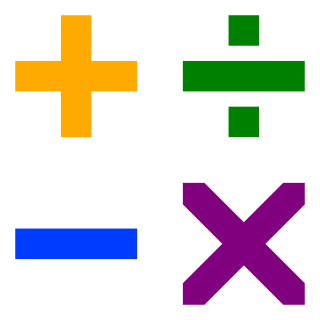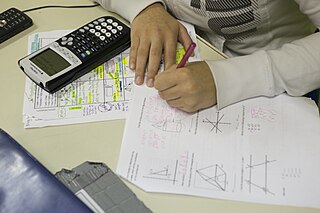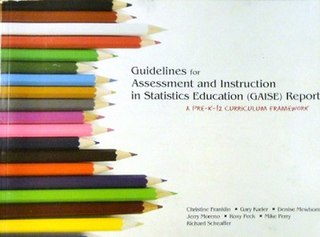
In contemporary education, mathematics education—known in Europe as the didactics or pedagogy of mathematics—is the practice of teaching, learning, and carrying out scholarly research into the transfer of mathematical knowledge.

New Mathematics or New Math was a dramatic but temporary change in the way mathematics was taught in American grade schools, and to a lesser extent in European countries and elsewhere, during the 1950s–1970s.
Principles and Standards for School Mathematics (PSSM) are guidelines produced by the National Council of Teachers of Mathematics (NCTM) in 2000, setting forth recommendations for mathematics educators. They form a national vision for preschool through twelfth grade mathematics education in the US and Canada. It is the primary model for standards-based mathematics.
Founded in 1920, The National Council of Teachers of Mathematics (NCTM) is a professional organization for schoolteachers of mathematics in the United States. One of its goals is to improve the standards of mathematics in education. NCTM holds annual national and regional conferences for teachers and publishes five journals.

Elementary arithmetic is a branch of mathematics involving basic numerical operations, namely addition, subtraction, multiplication and division. Due to the low level of abstraction, broad range of application, and position as the foundation of all mathematics, elementary arithmetic is generally known as the first branch of mathematics that is taught in schools.
In elementary arithmetic, a standard algorithm or method is a specific method of computation which is conventionally taught for solving particular mathematical problems. These methods vary somewhat by nation and time, but generally include exchanging, regrouping, long division, and long multiplication using a standard notation, and standard formulas for average, area, and volume. Similar methods also exist for procedures such as square root and even more sophisticated functions, but have fallen out of the general mathematics curriculum in favor of calculators. As to standard algorithms in elementary mathematics, Fischer et al. (2019) state that advanced students use standard algorithms more effectively than peers who use these algorithms unreasoningly. That said, standard algorithms, such as addition, subtraction, as well as those mentioned above, represent central components of elementary math.

Core-Plus Mathematics is a high school mathematics program consisting of a four-year series of print and digital student textbooks and supporting materials for teachers, developed by the Core-Plus Mathematics Project (CPMP) at Western Michigan University, with funding from the National Science Foundation. Development of the program started in 1992. The first edition, entitled Contemporary Mathematics in Context: A Unified Approach, was completed in 1995. The third edition, entitled Core-Plus Mathematics: Contemporary Mathematics in Context, was published by McGraw-Hill Education in 2015.
Mathematically Correct was a U.S.-based website created by educators, parents, mathematicians, and scientists who were concerned about the direction of reform mathematics curricula based on NCTM standards. Created in 1997, it was a frequently cited website in the so-called Math wars, and was actively updated until 2003.
Traditional mathematics was the predominant method of mathematics education in the United States in the early-to-mid 20th century. This contrasts with non-traditional approaches to math education. Traditional mathematics education has been challenged by several reform movements over the last several decades, notably new math, a now largely abandoned and discredited set of alternative methods, and most recently reform or standards-based mathematics based on NCTM standards, which is federally supported and has been widely adopted, but subject to ongoing criticism.
Investigations in Numbers, Data, and Space is a K–5 mathematics curriculum, developed at TERC in Cambridge, Massachusetts, United States. The curriculum is often referred to as Investigations or simply TERC. Patterned after the NCTM standards for mathematics, it is among the most widely used of the new reform mathematics curricula. As opposed to referring to textbooks and having teachers impose methods for solving arithmetic problems, the TERC program uses a constructivist approach that encourages students to develop their own understanding of mathematics. The curriculum underwent a major revision in 2005–2007.
The Interactive Mathematics Program (IMP) is a four-year, problem-based mathematics curriculum for high schools. It was one of several curricula funded by the National Science Foundation and designed around the 1989 National Council of Teachers of Mathematics (NCTM) standards. The IMP books were authored by Dan Fendel and Diane Resek, professors of mathematics at San Francisco State University, and by Lynne Alper and Sherry Fraser. IMP was published by Key Curriculum Press in 1997 and sold in 2012 to It's About Time.
Integrated mathematics is the term used in the United States to describe the style of mathematics education which integrates many topics or strands of mathematics throughout each year of secondary school. Each math course in secondary school covers topics in algebra, geometry, trigonometry and functions. Nearly all countries throughout the world, except the United States, normally follow this type of integrated curriculum.
Math wars is the debate over modern mathematics education, textbooks and curricula in the United States that was triggered by the publication in 1989 of the Curriculum and Evaluation Standards for School Mathematics by the National Council of Teachers of Mathematics (NCTM) and subsequent development and widespread adoption of a new generation of mathematics curricula inspired by these standards.
Singapore math is a teaching method based on the national mathematics curriculum used for first through sixth grade in Singaporean schools. The term was coined in the United States to describe an approach originally developed in Singapore to teach students to learn and master fewer mathematical concepts at greater detail as well as having them learn these concepts using a three-step learning process: concrete, pictorial, and abstract. In the concrete step, students engage in hands-on learning experiences using physical objects which can be everyday items such as paper clips, toy blocks or math manipulates such as counting bears, link cubes and fraction discs. This is followed by drawing pictorial representations of mathematical concepts. Students then solve mathematical problems in an abstract way by using numbers and symbols.
Connected Mathematics is a comprehensive mathematics program intended for U.S. students in grades 6–8. The curriculum design, text materials for students, and supporting resources for teachers were created and have been progressively refined by the Connected Mathematics Project (CMP) at Michigan State University with advice and contributions from many mathematics teachers, curriculum developers, mathematicians, and mathematics education researchers.
Reform mathematics is an approach to mathematics education, particularly in North America. It is based on principles explained in 1989 by the National Council of Teachers of Mathematics (NCTM). The NCTM document Curriculum and Evaluation Standards for School Mathematics (CESSM) set forth a vision for K–12 mathematics education in the United States and Canada. The CESSM recommendations were adopted by many local- and federal-level education agencies during the 1990s. In 2000, the NCTM revised its CESSM with the publication of Principles and Standards for School Mathematics (PSSM). Like those in the first publication, the updated recommendations became the basis for many states' mathematics standards, and the method in textbooks developed by many federally-funded projects. The CESSM de-emphasised manual arithmetic in favor of students developing their own conceptual thinking and problem solving. The PSSM presents a more balanced view, but still has the same emphases.
Algebra tiles are mathematical manipulatives that allow students to better understand ways of algebraic thinking and the concepts of algebra. These tiles have proven to provide concrete models for elementary school, middle school, high school, and college-level introductory algebra students. They have also been used to prepare prison inmates for their General Educational Development (GED) tests. Algebra tiles allow both an algebraic and geometric approach to algebraic concepts. They give students another way to solve algebraic problems other than just abstract manipulation. The National Council of Teachers of Mathematics (NCTM) recommends a decreased emphasis on the memorization of the rules of algebra and the symbol manipulation of algebra in their Curriculum and Evaluation Standards for Mathematics. According to the NCTM 1989 standards "[r]elating models to one another builds a better understanding of each".

Mathematics education in the United States varies considerably from one state to the next, and even within a single state. However, with the adoption of the Common Core Standards in most states and the District of Columbia beginning in 2010, mathematics content across the country has moved into closer agreement for each grade level. The SAT, a standardized university entrance exam, has been reformed to better reflect the contents of the Common Core. However, many students take alternatives to the traditional pathways, including accelerated tracks. As of 2023, twenty-seven states require students to pass three math courses before graduation from high school, while seventeen states and the District of Columbia require four. A typical sequence of secondary-school courses in mathematics reads: Pre-Algebra, Algebra I, Geometry, Algebra II, Pre-calculus, and Calculus or Statistics. However, some students enroll in integrated programs while many complete high school without passing Calculus or Statistics. At the other end, counselors at competitive public or private high schools usually encourage talented and ambitious students to take Calculus regardless of future plans in order to increase their chances of getting admitted to a prestigious university and their parents enroll them in enrichment programs in mathematics.

The Guidelines for Assessment and Instruction in Statistics Education (GAISE) are a framework for statistics education in grades Pre-K–12 published by the American Statistical Association (ASA) in 2007. The foundations for this framework are the Principles and Standards for School Mathematics published by the National Council of Teachers of Mathematics (NCTM) in 2000. A second report focused on statistics education at the collegiate level, the GAISE College Report, was published in 2005. Both reports were endorsed by the ASA. Several grants awarded by the National Science Foundation explicitly reference the GAISE documents as influencing or guiding the projects, and several popular introductory statistics textbooks have cited the GAISE documents as informing their approach.
Sybilla Beckmann is a Josiah Meigs Distinguished Teaching Professor of Mathematics, Emeritus, at the University of Georgia and a recipient of the Association for Women in Mathematics Louise Hay Award.





